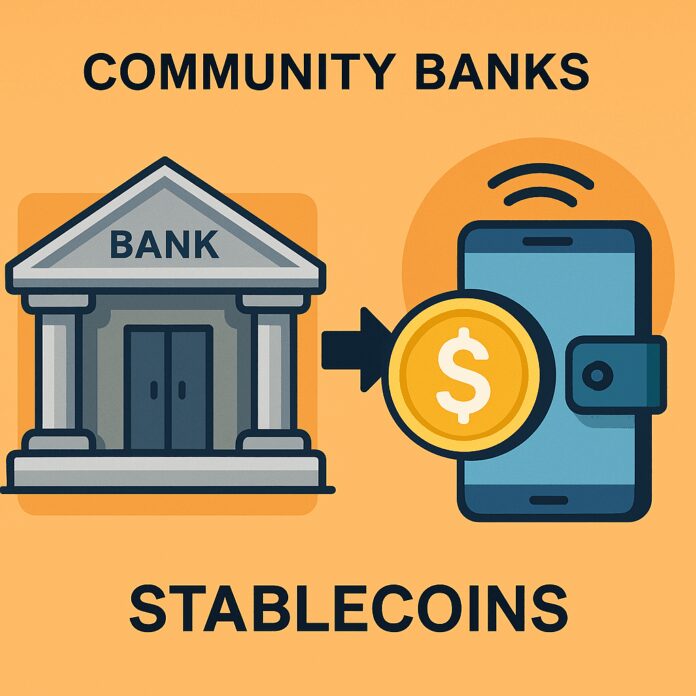Stablecoins are no longer just a tool for crypto enthusiasts — they are rapidly becoming a mainstream alternative to traditional bank deposits. This evolution represents a direct competitive threat to community banks and credit unions, forcing them to rethink their core business models.
The Shift: Stablecoins as a Substitute for Bank Deposits
Stablecoins now offer many of the same functions as traditional bank deposits:
- Storing value,
- Transferring funds,
- Facilitating payments, often at lower costs and higher speeds.
As they become integrated into mainstream financial apps and payment systems, they begin to undermine the deposit base of small regional banks. This raises a serious question: how can community banks remain relevant when money can move outside the banking system via decentralized rails?
According to PYMNTS, the growing popularity of stablecoins is a wake-up call for local financial institutions.
Regulatory Signals Favor Stablecoins
Recent comments from Jonathan Gould, head of the Office of the Comptroller of the Currency (OCC), suggest that crypto-related activities banks want to pursue are legally permissible and should not be stigmatized.
This opens the door for non-bank stablecoin issuers and fintechs to compete more aggressively with traditional banks, offering services like digital wallets and yield-bearing accounts — but without being held to the same rules.
Why This Matters for Community Banks
1. Deposit Flight Threatens Lending Capacity
When customers move their funds from checking or savings accounts into stablecoins, banks lose deposits, which are the foundation for making loans.
Fewer deposits mean less liquidity for mortgages, small business lending, and other core services.
Texas Bankers Association warns this could disrupt the entire local banking ecosystem.
2. Pressure on Margins
Stablecoin platforms often offer higher yields and lower fees, forcing banks to compete.
Smaller banks, which already operate with tight margins, risk being priced out of the market if they can’t match these offerings at scale.
As Acceleron Bank points out, this could fundamentally erode the business case for small banks.
3. Loss of Traditional Advantages
Community banks have historically relied on local relationships and trust to retain customers.
But as consumers — especially younger, tech-savvy demographics — embrace digital wallets and blockchain-based payments, these traditional advantages are losing their effectiveness.
Early Examples of Adaptation
Some community banks are taking bold steps.
For example, St. Cloud Financial Credit Union in Minnesota, with approximately $400 million in assets, announced plans to launch its own stablecoin, showing that smaller players can innovate too.
Others are exploring partnerships with fintechs or integrating blockchain-based payment rails to modernize their offerings.
Strategic Responses for Community Banks
To remain competitive, banks must evolve rapidly. Possible strategies include:
1. Issue or Partner on Stablecoins
Banks can create their own stablecoins or partner with trusted issuers to keep value within their ecosystem while offering programmable, digital-native money.
2. Integrate Digital Asset Services
Providing wallets, yield products, and tokenized assets ensures customers don’t need to leave the bank to access modern financial tools.
3. Leverage Trust and Local Advantage
While tech disruptors focus on speed and innovation, community banks can emphasize insured deposits, customer protection, and personalized service, creating a trusted bridge between traditional finance and digital assets.
4. Advocate for Regulatory Clarity
Banks must actively work with lawmakers to ensure fair rules.
Without regulation, non-bank issuers might gain an unfair advantage.
Stablecoin legislation like the GENIUS Act or STABLE Act could define future market dynamics.
5. Redefine the Business Model
Community banks need to go beyond competing on interest rates or branch service.
Instead, they must deliver real-time payments, embedded finance solutions, and digitally native offerings that meet customer expectations.
Risks of Moving Too Slowly
The transition comes with serious risks:
- Cybersecurity threats as banks integrate blockchain-based infrastructure.
- Compliance uncertainty, as stablecoin rules are still evolving.
- Reputational damage if banks partner with unstable or non-transparent stablecoin issuers.
- Being outpaced by larger institutions or fintechs, leaving small banks irrelevant.
What to Watch in the Coming Months
- The rollout of stablecoin regulation in Congress will be a critical turning point.
- Whether regulators give more guidance on bank-stablecoin partnerships.
- Adoption rates: as more consumers use stablecoins for day-to-day payments, the competitive threat to banks will accelerate.
- Innovation from community banks: early movers will shape how stablecoins and local financial institutions can coexist.
Conclusion
Stablecoins are no longer a fringe innovation — they are reshaping the financial landscape.
For community banks, this isn’t just a challenge to digitize; it’s a call to reimagine their role entirely.
The institutions that act now by embracing digital assets, regulatory engagement, and customer-first innovation can secure their place in the next generation of finance.
Those that hesitate risk being left behind as stablecoins become the default infrastructure for money movementworldwide.




